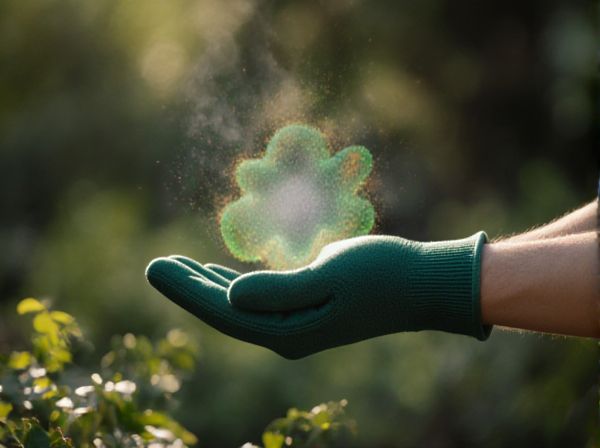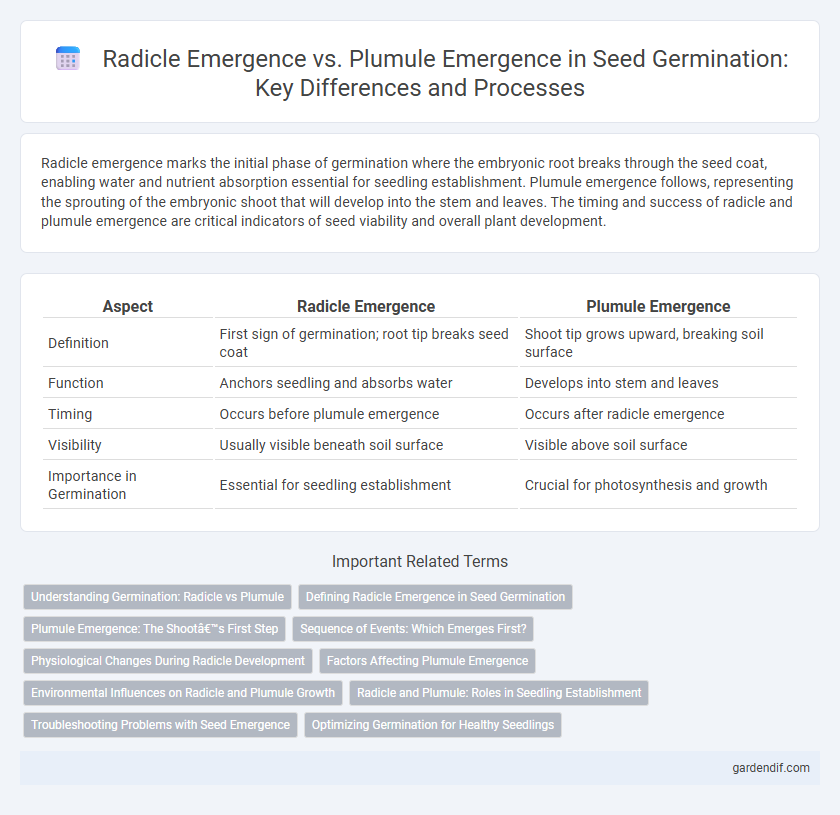
Radicle emergence vs Plumule emergence Illustration
Radicle emergence marks the initial phase of germination where the embryonic root breaks through the seed coat, enabling water and nutrient absorption essential for seedling establishment. Plumule emergence follows, representing the sprouting of the embryonic shoot that will develop into the stem and leaves. The timing and success of radicle and plumule emergence are critical indicators of seed viability and overall plant development.
Table of Comparison
| Aspect | Radicle Emergence | Plumule Emergence |
|---|---|---|
| Definition | First sign of germination; root tip breaks seed coat | Shoot tip grows upward, breaking soil surface |
| Function | Anchors seedling and absorbs water | Develops into stem and leaves |
| Timing | Occurs before plumule emergence | Occurs after radicle emergence |
| Visibility | Usually visible beneath soil surface | Visible above soil surface |
| Importance in Germination | Essential for seedling establishment | Crucial for photosynthesis and growth |
Understanding Germination: Radicle vs Plumule
Radicle emergence marks the initial phase of germination, where the embryonic root penetrates the seed coat to anchor and absorb water from the soil. Plumule emergence follows, signaling the growth of the embryonic shoot that develops into the stem and leaves, essential for photosynthesis. Understanding the timing and sequence of radicle and plumule emergence provides critical insights into seedling establishment and vigor.
Defining Radicle Emergence in Seed Germination
Radicle emergence is the initial phase of seed germination where the embryonic root breaks through the seed coat, marking the start of seedling establishment. This process signals the seed's transition from dormancy to active growth, enabling water and nutrient absorption essential for development. Radicle emergence precedes plumule emergence, which involves the shoot system growing upward toward light.
Plumule Emergence: The Shoot’s First Step
Plumule emergence marks the initial growth of the shoot from the seed, signaling the beginning of photosynthetic activity and upward plant development. This stage follows radicle emergence, where the root system establishes itself, allowing the plumule to access nutrients and light essential for growth. Successful plumule emergence is critical for seedling vigor and overall plant establishment in diverse environmental conditions.
Sequence of Events: Which Emerges First?
Radicle emergence occurs first in the germination process, marking the initial phase where the seed's embryo starts to grow by breaking through the seed coat. This primary root grows downward to anchor the seedling and absorb water and nutrients. The plumule, which develops into the shoot, emerges after the radicle has established, growing upward to reach light for photosynthesis.
Physiological Changes During Radicle Development
During radicle emergence, key physiological changes include the activation of hydrolytic enzymes that break down stored food reserves, providing energy for cell elongation and division. Water uptake increases turgor pressure, facilitating cell expansion in the radicle tip, which penetrates the seed coat. These processes establish root primordia essential for nutrient and water absorption, preceding plumule development.
Factors Affecting Plumule Emergence
Plumule emergence during germination is influenced by factors such as soil temperature, moisture availability, and oxygen levels, which are critical for cell elongation and division. The presence of light can also affect plumule growth, with some seeds requiring specific light conditions to trigger plumule emergence. Nutrient availability, particularly nitrogen and phosphorus, further supports the development of the plumule by facilitating metabolic processes essential for seedling establishment.
Environmental Influences on Radicle and Plumule Growth
Radicle emergence typically precedes plumule emergence and is highly influenced by soil moisture, temperature, and oxygen availability, which regulate water uptake and metabolic activation in the seed. Plumule growth is more sensitive to light exposure and temperature fluctuations, promoting chlorophyll synthesis and shoot elongation once the radicle establishes root function. Both growth phases rely on optimal environmental conditions to ensure successful seedling development and establishment.
Radicle and Plumule: Roles in Seedling Establishment
Radicle emergence marks the initial stage of germination, where the seed's embryonic root grows downward to anchor the seedling and begin water and nutrient absorption. Plumule emergence follows, developing into the shoot system responsible for photosynthesis and upward growth towards light. Together, radicle and plumule development coordinate to establish a stable seedling capable of sustaining growth and survival.
Troubleshooting Problems with Seed Emergence
Radicle emergence marks the initial phase of germination, as the embryonic root breaks through the seed coat, while plumule emergence follows when the shoot begins to grow upward. Troubleshooting seed emergence issues often involves examining factors like seed moisture, temperature, and soil compaction that can delay or inhibit radicle growth, ultimately affecting plumule development. Addressing oxygen availability and ensuring proper seed depth can prevent poor radicle and plumule emergence, improving overall seedling establishment.
Optimizing Germination for Healthy Seedlings
Radicle emergence marks the initial breakthrough during germination, signaling the seed's start of water and nutrient absorption critical for seedling development. Plumule emergence follows, developing the first true leaves essential for photosynthesis and further growth. Optimizing germination by controlling moisture, temperature, and oxygen levels ensures strong radicle and plumule development, leading to healthy, vigorous seedlings.
Radicle emergence vs Plumule emergence Infographic

 gardendif.com
gardendif.com